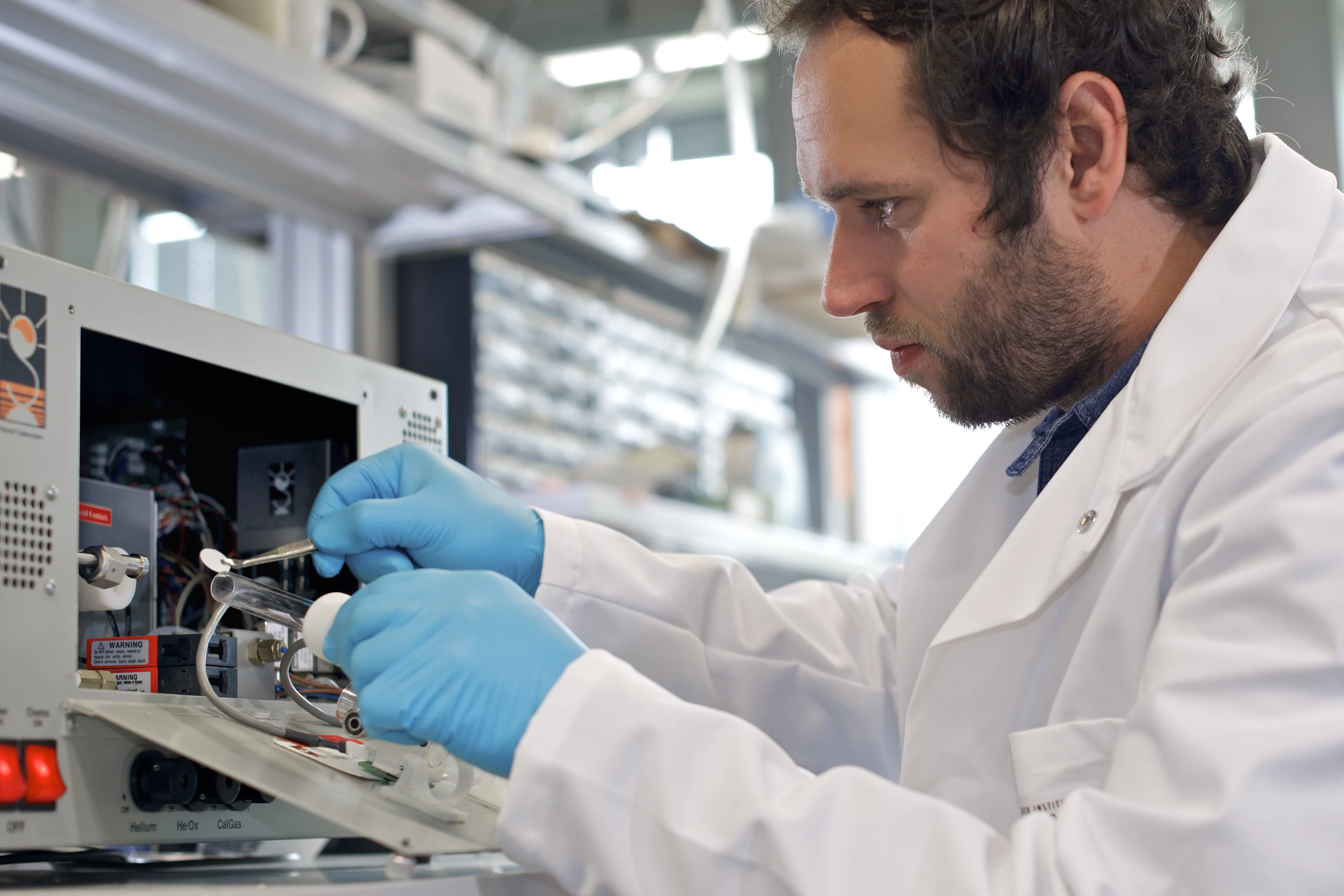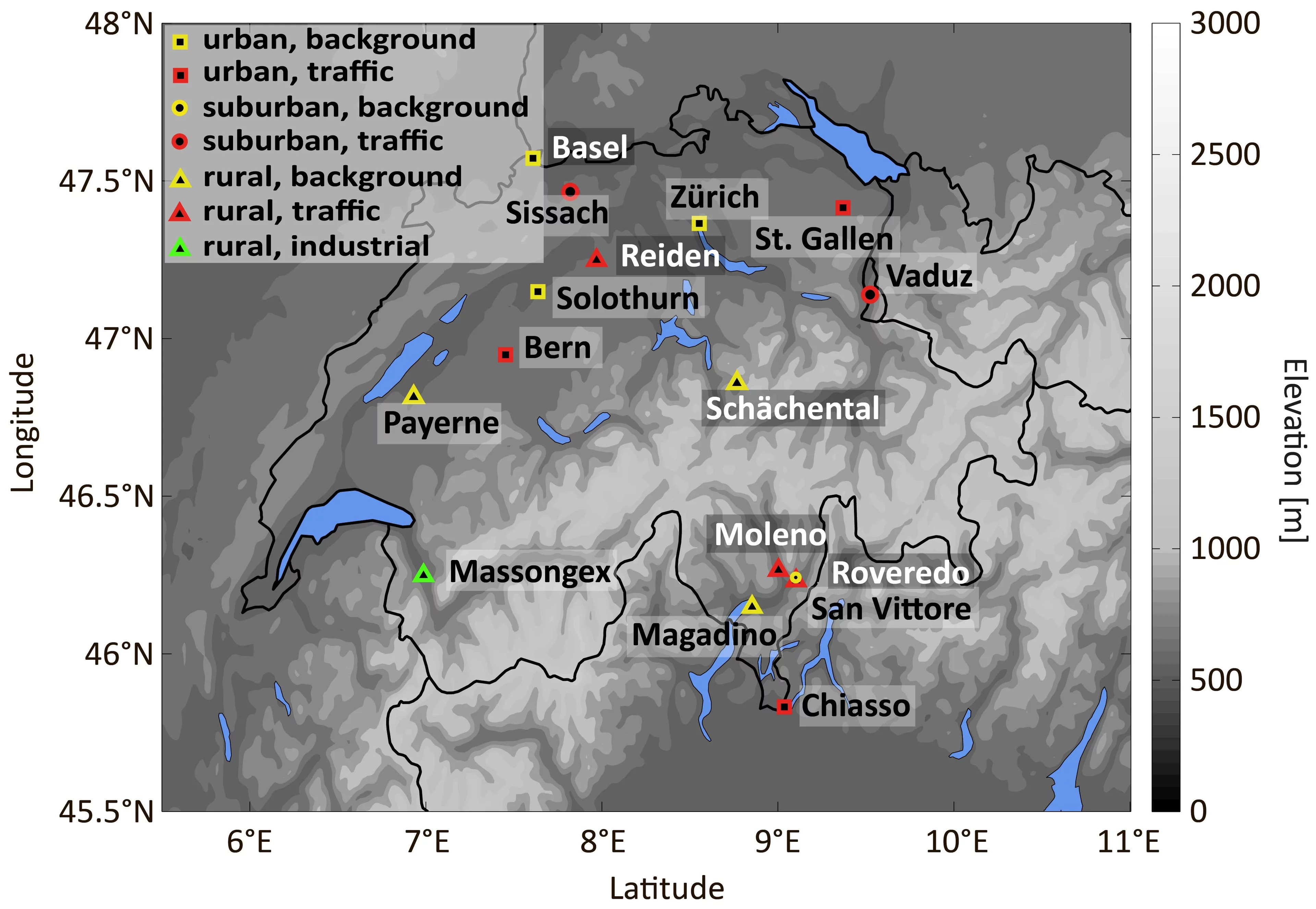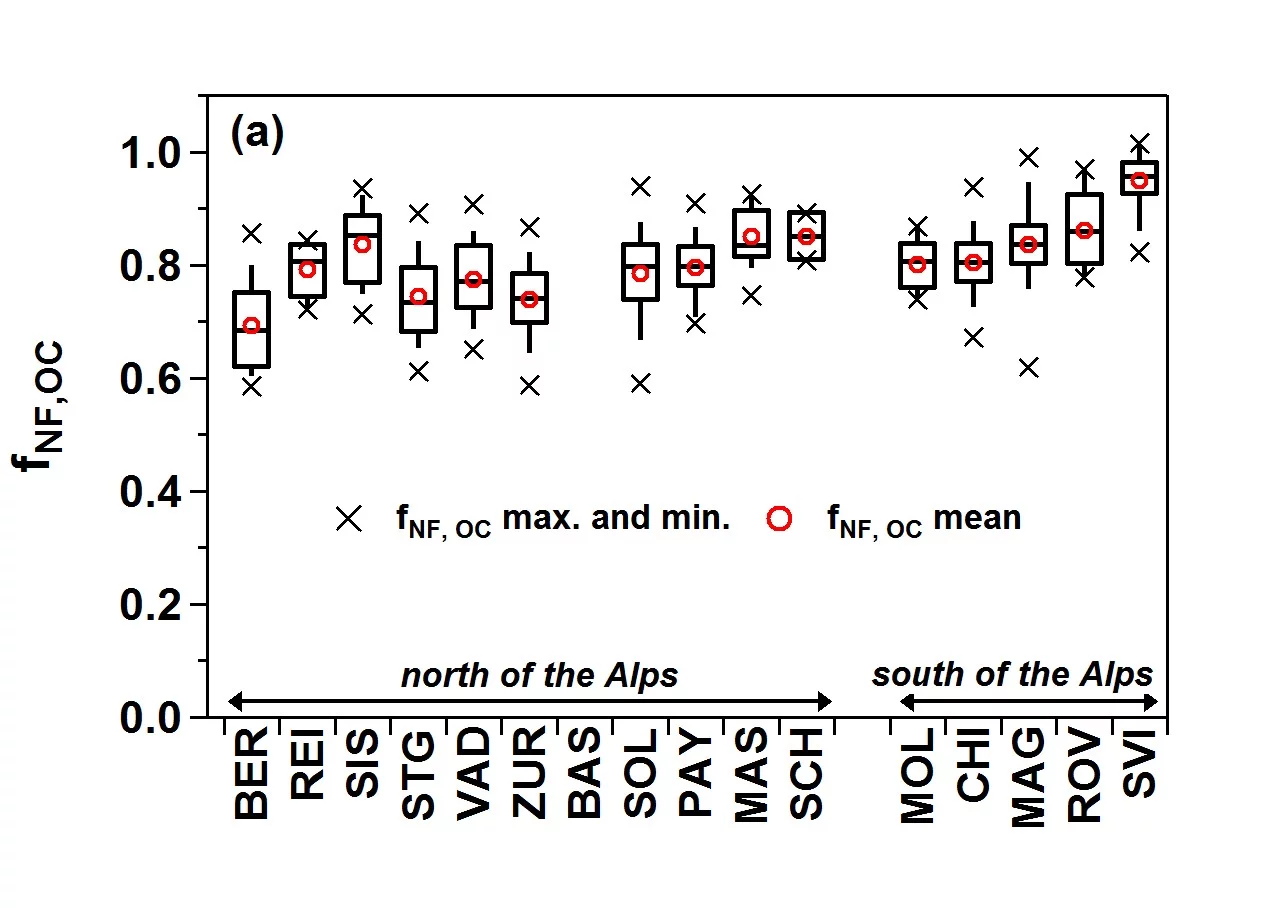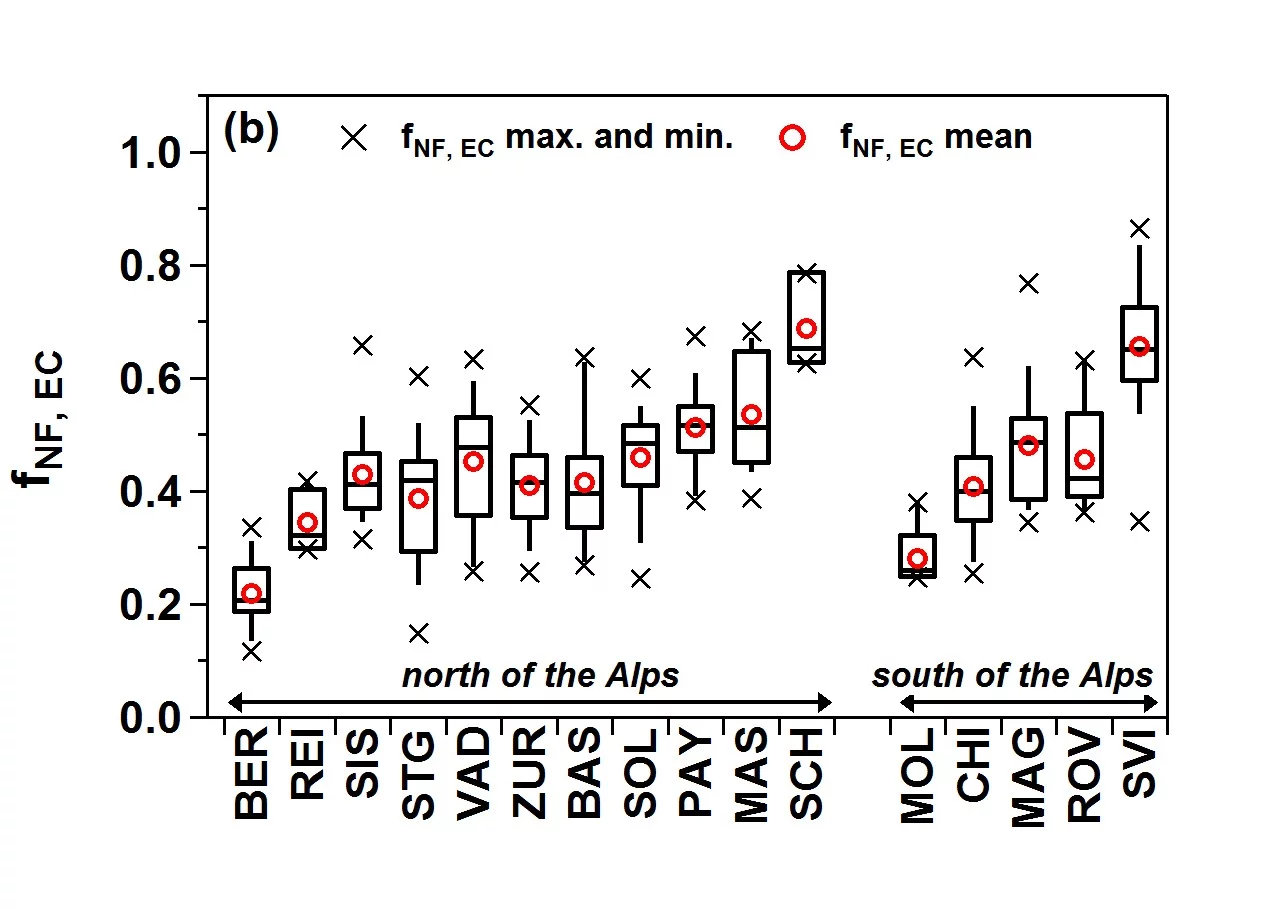On winter smog days in Switzerland wood burning is the main source of harmful carbon-containing fine particles. This is revealed by a large-scale Swiss study on fine particle pollution conducted over a five-year period by scientists at the Paul Scherrer Institute (PSI), the University of Bern and ETH Zurich.
Experts use the term fine particulate matter for suspended particles in the air with a diameter of up to 10 thousandth millimetres (10 micrometres). Whereas large fine dust particles get stuck in the throat and nose, smaller particles with a diameter of up to 2.5 micrometres can reach the lungs and from there the bloodstream. The fine dust can cause respiratory and cardiovascular disorders. It has been proven that elevated fine dust concentrations in air lead to higher mortality rates. In Europe fine particulate matter is one of the most harmful forms of air pollution.
A new study with the participation of PSI looks at fine dust pollution during winter smog in Switzerland. For their measurements the researchers use what is known as the C-14 technique. Based on radioactive carbon content in a sample, it can determine whether the fine particles stem from fossil or non-fossil sources.
In the study C-14-measurements were taken of fine particle samples over a period of 5 years at 16 measurement stations both north (11 stations) and south (5 stations) of the Alps. To obtain a representative picture, the measurement data were collected in agglomerations, villages and Alpine valleys in addition to the urban stations. Given the density of the measurement stations and the long period over which data are collected, this C-14 study is unique in the world.
In all five winters samples collected from all stations were analysed on five days on which the European and Swiss limit value for fine particulate matter pollution had been exceeded. The study didn’t look at the mean values of fine particle pollution over a winter season but at the extremes that typically occur during winter smog.
Source attribution through radioactive carbon
The PSI scientists used the C-14-method to attribute the carbon in fine particles to a fossil or non-fossil source. The technique is based on the fact that fossil fuels only contain the non-radioactive form of the carbon atom. By contrast, non-fossil biomass like wood contains traces of the radioactive form of carbon (C-14). It is continuously formed in the upper layers of the atmosphere and is absorbed from CO2 in the air by the biomass. C-14 is a heavy variant (isotope) of the carbon atom and occurs in the atmosphere 1 billion times less often than the most frequently available stable 12C isotope. In contrast to C-12, C-14 is radioactive and has a half-life of 5,730 years. Over the millions of years that fossil fuels like mineral oil, gas or coal take to form inside the earth’s core, C-14 decays completely which means that fossil materials unlike “fresh” biomass no longer contain any C-14.
Furthermore, in the study the carbon content in fine dust was divided into elementary and organic carbon. Elementary carbon (an important component in soot) is only formed during combustion processes whereas organic carbon may stem from many different sources besides combustion and traffic, for instance from emissions from forests and cooking. “A major challenge involved separately extracting these two carbon variants from fine particle samples for C-14 measurement – a technique that is only mastered by a few research groups today. We succeeded in this study thanks to the co-operation between PSI and the University of Bern”, says the PSI doctoral student Peter Zotter, who conducted the research.
As elementary carbon (EC, also known as black carbon) can only be emitted during combustion processes, source attribution is relatively simple in this case. The lion’s share either comes from the combustion engines of cars or from wood burning (fossil emissions of elementary carbon from industry, gas and oil heating and non-fossil inputs from forest fires, waste incineration plants and barbecues are on a small scale in Switzerland). This, in turn, means that the fossil share can be attributed fully to transport, the non-fossil share to wood-burning stoves.
The situation is more complex in the case of organic carbon. It can stem from various sources – besides wood burning and traffic also from biogenic sources like forest or cooking emissions. Furthermore, the organic fine particulate matter can be either directly emitted or formed in the atmosphere through the conversion of volatile gaseous hydrocarbons into fine particles. However, in this study the non-fossil organic carbon was mostly attributed to wood burning since there are almost no emissions from forests in winter in Switzerland and cooking emissions account for a smaller share. A strong indication of wood burning as a main source is that the concentrations of non-fossil organic carbon correlate with those of the molecule levoglucosan. Levoglucosan is formed during thermal decomposition (pyrolysis) of cellulose, the main component of wood. Levoglucosan is therefore a marker for wood burning.
Differences between north and south
The C-14 measurements paint a different picture of fine particle pollution for north and south Switzerland: north of the Alps the non-fossil share of organic carbon in fine particulate matter is between 70 and 87 percent depending on the station. This, therefore, means that the fossil share and, by extension, the contribution of road traffic to organic carbon amounts to not more than 30 percent in the north. South of the Alps the contribution of combustion engines is even smaller: there only up to 19 percent of pollution with organic carbon is caused by mobility. The predominant contribution of the non-fossil share both north and south of the main chain of the Alps highlights the importance of wood heating for the fine particle pollution peaks in winter.
A glimpse at the measurement data for carbon black confirms this picture. In this case the pollution at most of the measurement stations stems primarily from fossil sources, i.e. from traffic. Nonetheless, traffic and wood burning are more or less on an even par when it comes to carbon black pollution at a few stations. In the Schächental valley and in San Vittore (Graubünden ) wood burning accounts for as much as 70 and 86 percent respectively.
More efficient wood burning in the north
The study concludes that measures for the reduction of fine particle pollution in Switzerland should focus more on wood burning, since further reductions in fine particle emissions from vehicles are to be expected in future. One possible option would be support for more up-to-date and more efficient wood- burning stoves. They emit less black carbon and, more particularly, fewer organic carbon compounds because they achieve a more complete combustion. The PSI researchers did indeed establish in this study that relatively less organic carbon is emitted from wood combustion to the north of the Alps in the densely populated Mittelland – an indication that on average more efficient wood-burning stoves are used there than in the south.
This study received financial support from the Federal Office for the Environment (FOEN), Canton Basel-City, Basel-Landschaft, Graubünden, Solothurn, Ticino and Wallis and from OSTLUFT, inNET Monitoring AG and the Principality of Liechtenstein
Text: Paul Scherrer Institute/Leonid Leiva
Additional information
Laboratory of atmospheric chemistryContact
Dr. André Prévôt, Head of the group gas phase and aerosol chemistry, Paul Scherrer Institute,Telephone: +41 56 310 42 02, E-mail: andre.prevot@psi.ch
Original publication
Radiocarbon analysis of elemental and organic carbon in Switzerland during winter-smog episodes from 2008 to 2012 – Part 1: Source apportionment and spatial variabilityP. Zotter, V. G. Ciobanu, Y. L. Zhang, I. El-Haddad, M. Macchia, K. R. Daellenbach, G. A. Salazar, R.-J. Huang, L. Wacker, C. Hueglin, A. Piazzalunga, P. Fermo, M. Schwikowski, U. Baltensperger, S. Szidat, A. S. H. Prévôt
Atmospheric Chemistry and Physics, 14, 13551-13570, 2014
DOI: 10.5194/acp-14-13551-2014




